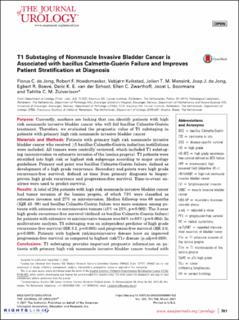| dc.contributor.author | de Jong, Florus C. | |
| dc.contributor.author | Hoedemaeker, Robert F. | |
| dc.contributor.author | Kvikstad, Vebjørn | |
| dc.contributor.author | Mensink, Jolien T M | |
| dc.contributor.author | de Jong, Joep J. | |
| dc.contributor.author | Boevé, Egbert R. | |
| dc.contributor.author | van der Schoot, Deric K E | |
| dc.contributor.author | Zwarthoff, Ellen C. | |
| dc.contributor.author | Boormans, Joost L. | |
| dc.contributor.author | Zuiverloon, Tahlita C M | |
| dc.date.accessioned | 2022-02-04T12:40:19Z | |
| dc.date.available | 2022-02-04T12:40:19Z | |
| dc.date.created | 2022-02-01T13:21:13Z | |
| dc.date.issued | 2021-03 | |
| dc.identifier.citation | de Jong, F.C., Hoedemaeker, R.F., Kvikstad, V., Mensink, J. T. M., de Jong, J.J., Boevé, E.R., van der Schoot, D.K.E., Zwarthoff, E.C., Boormans, J.L., Zuiverloon, T.C.M. (2021) T1 Substaging of Nonmuscle Invasive Bladder Cancer is Associated with bacillus Calmette-Guérin Failure and Improves Patient Stratification at Diagnosis. Journal of Urology, 205 (3), 701-708. | en_US |
| dc.identifier.issn | 0022-5347 | |
| dc.identifier.uri | https://hdl.handle.net/11250/2977192 | |
| dc.description.abstract | Purpose:
Currently, markers are lacking that can identify patients with high risk nonmuscle invasive bladder cancer who will fail bacillus Calmette-Guérin treatment. Therefore, we evaluated the prognostic value of T1 substaging in patients with primary high risk nonmuscle invasive bladder cancer.
Materials and Methods:
Patients with primary high risk nonmuscle invasive bladder cancer who received ≥5 bacillus Calmette-Guérin induction instillations were included. All tumors were centrally reviewed, which included T1 substaging (microinvasion vs extensive invasion of the lamina propria). T1 patients were stratified into high risk or highest risk subgroups according to major urology guidelines. Primary end point was bacillus Calmette-Guérin failure, defined as development of a high grade recurrence. Secondary end points were high grade recurrence-free survival, defined as time from primary diagnosis to biopsy-proven high grade recurrence and progression-free survival. Time-to-event analyses were used to predict survival.
Results:
A total of 264 patients with high risk nonmuscle invasive bladder cancer had tumor invasion of the lamina propria, of which 73% were classified as extensive invasion and 27% as microinvasion. Median followup was 68 months (IQR 43–98) and bacillus Calmette-Guérin failure was more common among patients with extensive vs microinvasive tumors (41% vs 21%, p=0.002). The 3-year high grade recurrence-free survival (defined as bacillus Calmette-Guerin failure) for patients with extensive vs microinvasive tumors was 64% vs 83% (p=0.004). In multivariate analysis, T1 substaging was an independent predictor of high grade recurrence-free survival (HR 3.2, p=0.005) and progression-free survival (HR 3.0, p=0.009). Patients with highest risk/microinvasive disease have an improved progression-free survival as compared to highest risk/T1e disease (p.adj=0.038).
Conclusions:
T1 substaging provides important prognostic information on patients with primary high risk nonmuscle invasive bladder cancer treated with bacillus Calmette-Guérin. The risk of bacillus Calmette-Guérin failure is higher in extensive vs microinvasive tumors. Substaging of T1 high risk nonmuscle invasive bladder cancer has the potential to guide treatment decisions on bacillus Calmette-Guérin vs alternative strategies at diagnosis. | en_US |
| dc.language.iso | eng | en_US |
| dc.publisher | American Urological Association | en_US |
| dc.rights | Attribution-NonCommercial-NoDerivatives 4.0 Internasjonal | * |
| dc.rights.uri | http://creativecommons.org/licenses/by-nc-nd/4.0/deed.no | * |
| dc.subject | blærekreft | en_US |
| dc.subject | onkologi | en_US |
| dc.title | T1 Substaging of Nonmuscle Invasive Bladder Cancer is Associated with bacillus Calmette-Guérin Failure and Improves Patient Stratification at Diagnosis | en_US |
| dc.type | Peer reviewed | en_US |
| dc.type | Journal article | en_US |
| dc.description.version | publishedVersion | en_US |
| dc.rights.holder | © 2021 The Author(s). | en_US |
| dc.subject.nsi | VDP::Medisinske Fag: 700::Klinisk medisinske fag: 750::Onkologi: 762 | en_US |
| dc.source.pagenumber | 701-708 | en_US |
| dc.source.volume | 205 | en_US |
| dc.source.journal | Journal of Urology | en_US |
| dc.source.issue | 3 | en_US |
| dc.identifier.doi | 10.1097/JU.0000000000001422 | |
| dc.identifier.cristin | 1996306 | |
| cristin.ispublished | true | |
| cristin.fulltext | original | |
| cristin.qualitycode | 2 | |

